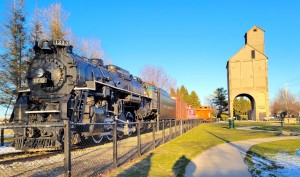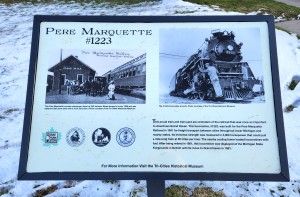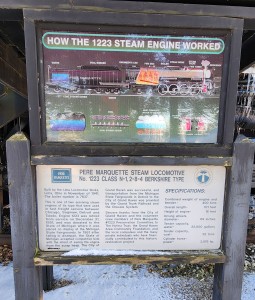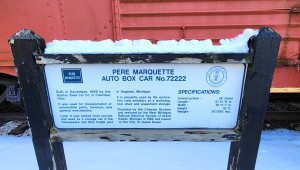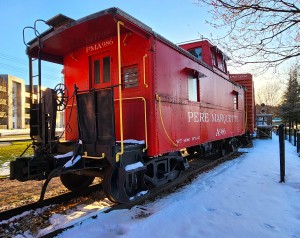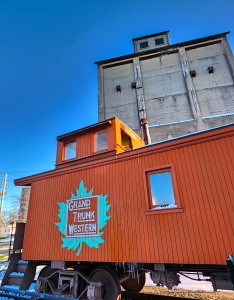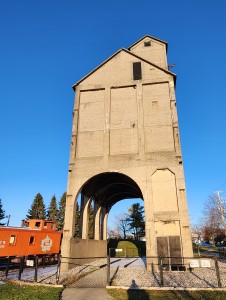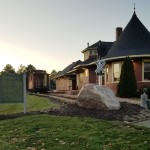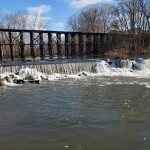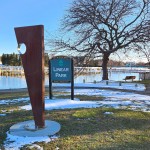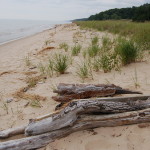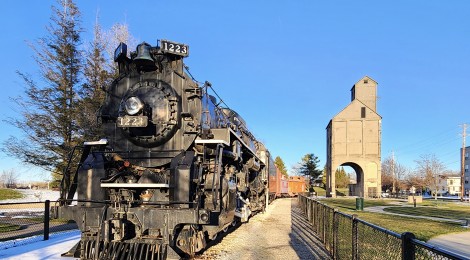
Michigan Roadside Attractions: Pere Marquette Steam Engine and Coal Tower, Grand Haven
Michigan Roadside Attractions on Travel the Mitten highlights our attempts to explore the many interesting things that can be found on the highways, byways and back roads of Michigan, ranging from the interesting to the unusual.
We’ve driven by the Pere Marquette steam engine and coal tower in Grand Haven many times without ever stopping to take pictures or find out more about their significance. When we were in the area in March we finally stopped to check out the steam engine and the other train cars that sit behind it and were able to learn more from the informational signs in the park. If you’ve ever driven by this on the way to the beach or lighthouse in Grand Haven and thought “hey that’s a cool train,” today we’re here to share some knowledge on just how cool this local landmark is.
First up is the stunning Pere Marquette #1223 steam engine, and a sign nearby tells us a little bit about its history: “This proud train and train yard are reminders of the railroad that was once so important to downtown Grand Haven. This locomotive, #1223, was built for the Pere Marquette railroad in 1941 for freight transport between cities throughout lower Michigan and nearby states. Its immense strength was measured in 3,000 horsepower that could pull a mile-long train at 50 miles per hour. The nearby coaling tower loaded locomotives with fuel. After being retired in 1951, this locomotive was displayed at the Michigan State Fairgrounds in Detroit until its move to Grand Haven in 1981.” A sign on the other side of the steam engine has a diagram showing how it worked and more information about its history.
The combined weight of the engine and tender is 400 tons, its overall length is 101 feet, and the height of the engine is 16 feet. The diameter of the driving wheels is 69 inches, the water capacity of the tender was 22,000 gallons and 22 tons of coal, and the official horsepower measurement was 2,979 hp.
Behind the steam engine is a restored box car that was built in 1941. It was “used for transportation of automobile parts, furniture, and general merchandise.” The car is currently used for storage of work materials used by the restoration crew members.
After the box car you will find a bright red Pere Marquette caboose from 1941. “The caboose was truly a rolling office, complete with a coal stove, ice box, drinking water tank, sink, and sleeping bunks.” This caboose was used on night runs from Muskegon to Grand Haven to Grand Rapids, and was retired in 1981.
Finally, bringing up the rear is the eye-catching orange caboose from the Grand Trunk Western railroad. It is an all-wood caboose dating back to at least the 1920s, and was used as a mobile office as well as where the brakeman sat and observed the train when it was in motion.
It was awesome to see all of these historic train cars and how well they had been restored. After a final pass we stopped by the sign that tells more about the coaling tower. It reads: “The coal tipple is a concrete structure that is not only recognizable as a monument of the Grand Haven skyline, but as a vestige of the railroad era that played a major role in the development of the Tri Cities. Seated at the mouth of the Grand River, Grand Haven became a major port for transporting passengers and freight and propelled the development of the railroad system and stations in the area. The railroad was synonymous with prosperity as it improved accessibility and communications, and the train depot became the social and business center of town. The coal tipple was built in 1925, an expensive endeavor that only the most prosperous railroads could afford to build. Railroad freight cars, also known as hopper cars, were loaded with coal and pushed under the tipple’s arches. The coal was dumped into a large pit beneath the rails and conveyed to the storage vault at the top of the tower. The coal could then be loaded into the coal car behind the engine through metal chutes on either side of the tower. Two trains could be loaded at one time.” It is noted here that this is the only structure of its kind that is readily accessible to the public, though a fence keep visitors from going underneath due to the risk of falling debris.

